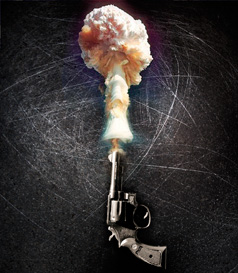The discussion of the Tucson tragedy should be familiar, as we witness similar massacres in U.S. schools, shopping centers, and other public places played out periodically. Each time, the NRA and other gun apologists tell us that the easy accessibility of firearms, including assault weapons, had nothing to do with it. Indeed, they argue that the key to our safety is to obtain more guns.
But does the fact that nearly 100,000 Americans are shot with guns and nearly 10,000 Americans are killed with them each year really have no connection to the remarkable availability of guns in the United States?
A great deal of evidence suggests otherwise. For example, according to a recent study, when twenty-three populous, high-income countries were compared for the year 2003, it was found that, among civilians, the United States had more firearms and more handguns per capita than the other countries, as well as the most permissive gun control laws. Not surprisingly, the firearm homicide rate in the United States was 19.5 times higher than in the other countries. The U.S. unintentional firearm death rate was 5.2 times higher.
Although this death toll is bad enough, consider also the fact that the same dynamics operate in international relations. No nation in recent decades has rivaled the military might of the United States. Indeed, the U.S. government spends nearly as much on its military forces as the rest of the world combined—presumably, to keep Americans safe. But are they safe? Not long ago, the greatest terrorist attack in history occurred in the United States, and more are constantly threatened. Meanwhile, U.S. military forces have been dying or coming home crippled from two very bloody, seemingly endless wars. Could a key reason for this disastrous situation be that brandishing more and more weapons not only fails to protect us, but actually pulls us into a deadly cycle of violence?
Of course, the safety through weapons theory is particularly dangerous when it comes to nuclear weapons. Like the NRA, nuclear zealots assure us that massive nuclear arsenals will make us safer. Thus, as the price for approving the recent New START Treaty, they demanded—and received—a hefty payoff: a commitment from the Obama administration for $180 billion in funding over the next decade for “modernization” of the U.S. nuclear weapons production complex and the U.S. nuclear arsenal. But this kind of nuclear buildup encourages nuclear nations to do the same thing and helps convince non-nuclear nations to develop their own nuclear arms. Aren’t we supposed to be working for a world free of nuclear weapons?
Certainly, that would be a good idea. The more nuclear weapons that are available, the more likely it is that terrorists will acquire and use them, that embattled governments will employ them in their wars, and that they will be fired or exploded accidentally. We have had some close scrapes along these lines in recent years. These include terrorist nuclear plots, nations drawn to the brink of nuclear war, and the collision of nuclear submarines. Disarmament activists are sometimes accused of naïveté. But isn’t it far more naive to assume that, in an angry world bristling with nuclear weapons, they will never be used?
And so we are brought back to the mass murder in Tucson and the question: Are we safer with more firepower or less? Despite the propaganda of the gunslingers, the arms manufacturers, and the military enthusiasts, it does seem that the world would be a lot safer with fewer guns and fewer nuclear weapons.
Dr. Wittner is Professor of History at the State University of New York/Albany. His latest book is Confronting the Bomb: A Short History of the World Nuclear Disarmament Movement (Stanford University Press).
Our most important fundraising appeal of the year
December is the most critical time of year for Truthout, because our nonprofit news is funded almost entirely by individual donations from readers like you. So before you navigate away, we ask that you take just a second to support Truthout with a tax-deductible donation.
This year is a little different. We are up against a far-reaching, wide-scale attack on press freedom coming from the Trump administration. 2025 was a year of frightening censorship, news industry corporate consolidation, and worsening financial conditions for progressive nonprofits across the board.
We can only resist Trump’s agenda by cultivating a strong base of support. The right-wing mediasphere is funded comfortably by billionaire owners and venture capitalist philanthropists. At Truthout, we have you.
We’ve set an ambitious target for our year-end campaign — a goal of $250,000 to keep up our fight against authoritarianism in 2026. Please take a meaningful action in this fight: make a one-time or monthly donation to Truthout before December 31. If you have the means, please dig deep.
